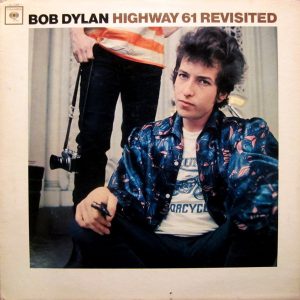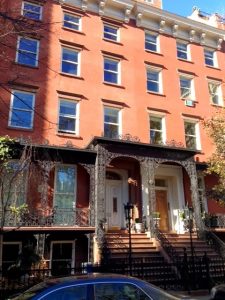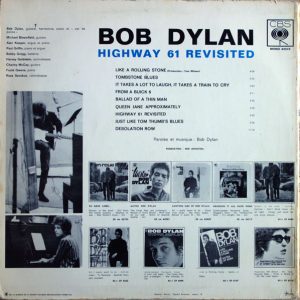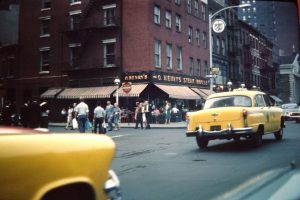This article is part of a series that reviews the art work of over 30 of Bob Dylan’s albums. There is a list of previous articles with links to their pages on this site, below.
by Patrick Roefflaer
- Released September 30, 1965
- Photographer Daniel Kramer
- Liner Notes Bob Dylan
- Art-director John Berg
“Usually you have a plan, especially for a cover. And this wasn’t the plan.”- Daniel Kramer, 2015
At 1pm on Friday December 3rd 1965 Bob Dylan faces the press in the KQED Studios in San Francisco to promote his five Bay Area shows. Dylan is twenty-four and not really enjoying this sort of obligation. The first question is about the cover of his recently released album, Highway 61 Revisited.
Q: I’d like to know the meaning of the cover photo on your album? I’d like to know the meaning of the photograph with you wearing the Triumph T-shirt.
A. What would you like to know about it?
Q: It seems to have some philosophy in it. I’d like to know visually what it represents to you – you’re a part of it..
A: I haven’t really looked at it that much.
Q: I’ve thought about it a great deal.
A: It was just taken one day when I was sitting on the steps y’know – I don’t really remember too much about it.
Q: What about the motorcycle as an image in your songwriting. You seem to like that.
A: Oh, we all like motorcycles to some degree.
 Yet although it wasn’t planned, the iconic image on the cover of Dylan’s second electrically amplified album was no fluke.
Yet although it wasn’t planned, the iconic image on the cover of Dylan’s second electrically amplified album was no fluke.
The photo was taken sometime in the Summer of 1965, by Daniel Kramer – the same photographer who made the iconic photo that graces Dylan’s previous album Bringing It All Back Home.
Kramer was a privileged witness in Dylan’s transition from folk singer to rock star, as he found himself photographing Dylan on thirty occasions between August 27, 1964 and August 28, 1965. Hence, the title of his book, Bob Dylan: A Year and a Day (Taschen, 2016). (Note 1)
The photoshoot for Highway 61 Revisited takes place after the recording of “Like A Rolling Stone,”(June 15-16) but before the start of the rest of the sessions for the album (July 29 – August 4).
Kramer explained that he met Dylan “at his apartment”.
Generally, it’s assumed that this must have been the apartment at 161 West 4th Street in the West Village. That was Dylan’s first permanent address in New York, after crashing on couches for almost a year. He went to live in this apartment with his girlfriend, Suze Rotolo, in December 1961, shortly after the recording of his debut album.
 From April 1964, after the break with Suze, he lived a while in the house of Saturday Evening Post journalist Al Aronowitz, where he could hide from the fans.
From April 1964, after the break with Suze, he lived a while in the house of Saturday Evening Post journalist Al Aronowitz, where he could hide from the fans.
In November 1964, while Albert Grossman was on honeymoon, Bob moved into his manager’s apartment at Gramercy Park, with his new girlfriend Sara and her daughter Maria.
Gramercy Park is a small parcel of a private park between East 20th and 21st Streets and 3rd Avenue and Park Avenue South. Only keyholders of any of the buildings surrounding the park can enter it. Dylan’s manager Albert Grossman had an apartment in the stately mansion at No. 4.
In December 1964 Bob took his new family to the Chelsea Hotel on West 23rd Street. Their room 211 was a modest suite with a bedroom on the backside of the building.
As Dylan is notoriously private, it is unlikely he would invite the photographer to his room at the Chelsea Hotel. So, it’s more likely that the journey for the photo shoot started and ended at Grossman’s apartment at 4 Gramercy Park.
So, on that Summer’s day, the singer is waiting for his guest at the apartment, in the company of his friend and bodyguard Bob Neuwirth.
For two out of the five photoshoots for his albums he has released before this, the idea was to walk out on the street and see what happened. It was Don Hunstein who suggested this for The Freewheelin’ Bob Dylan and it also worked for Sandy Speiser for Another Side of Bob Dylan.
 So, the three of them hit the street. At some time, Kramer might have mentioned that he feels the clothes Bob is wearing are a bit plain for a photo session, so they go shopping for a more colourful outfit.
So, the three of them hit the street. At some time, Kramer might have mentioned that he feels the clothes Bob is wearing are a bit plain for a photo session, so they go shopping for a more colourful outfit.
After that they take a rest at a restaurant on the corner of 6th Avenue and West 4th Street, called O. Henry’s Steak House. On the picture Bob can be seen wearing the costume he just bought.
 Finally, they head back to Gramercy Park, a twenty-minute walk.
Finally, they head back to Gramercy Park, a twenty-minute walk.
There Dylan changes into something more casual. From his new gear he chooses a Triumph motorcycle T-shirt and a silk shirt.
Dressed like this, he sits down on the stairs of the front porch of No. 4, in his hand his Ray-Ban glasses with dark lenses.
“Usually you have a plan”, Kramer explains in an interview with Bob Egan (notes 2 and 3). ‘Especially for a cover. And this wasn’t the plan.”
“This [Kramer points at the left side of the picture on the sleeve] was kind of… all naked here. So, I asked Neuwirth to stand there. So I grabbed my camera [a 35mm Range Finder Nikon] and said, ‘Hold this camera’.
“Once he did that, it seems like something’s going on. Not that we’re taking the picture, but there’s a making of a picture: there’s a photographer, he’s got his camera…”
 “This wasn’t the plan”, Kramer repeats. “This wasn’t even expected that we would do a picture like this.”
“This wasn’t the plan”, Kramer repeats. “This wasn’t even expected that we would do a picture like this.”
Although Bob Egan says that Kramer only took two photos, this appears not to be true.
The picture confirms the image presented on the cover of Bringing It All Back Home: Dylan is no longer a folk singer, but a rock and roll star. About Dylan’s menacing look at the selected photo, the photographer says in 2010: “He looks hostile or at least moody. He seems to challenge me – or whoever he looks at – “What are you going to do about it, dude?”
As on the previous album, Columbia art director John Berg provides the photo with a white frame.
 On the back sleeve, the space is mostly filled with quirky prose by Bob Dylan. The surreal text is accompanied by three black and white photos of the singer in the studio, also made by Daniel Kramer (note 4).
On the back sleeve, the space is mostly filled with quirky prose by Bob Dylan. The surreal text is accompanied by three black and white photos of the singer in the studio, also made by Daniel Kramer (note 4).
The very first American mono pressing included a portrait drawing. On the left, the signature ‘Lambert’ is legible (note 5). The drawing was enclosed in the plastic protective film, over the back of the cover. Because the song titles were not visible, a strip with the titles and playback times was enclosed at the bottom of the front. The drawing was already announced on the front with a sticker: ‘FREE! INCLUDES A STRIKING PORTRAIT SUITABLE FOR FRAMING’.
The title Highway 61 Revisited is a reference to U.S. Route 61, a highway that runs across the United States, parallel to the Mississippi, from Minnesota all the way down to New Orleans.
It is the Blues Highway that the black people followed from the plantations in the South to the industrial cities in the North, which brought with it the transition from the acoustic blues to the electric blues.
Notes:
- For more details about Daniel Kramer see the story about the art work of Bringing It All Back Home
- Thanks to Bob Egan for finding the exact location of the shoot and shearing it on his fabulous website PopSpots
- The interview is part of a mini documentary, posted in October 2015 on RollingStone.com:
- On the back of the cover of the British pressings there is only one photo of Bob Dylan: at the piano.
On the original French pressings, two of the three photos are present, but the text is missing. The free space is used by advertising for some other albums. However the album is presented in a gatefold sleeve containing a French translation of the lyrics on the inside. - Saul Lambert (1928-2009) was a painter and illustrator, perhaps most famous for his self-illustrated book Mrs. Poggi’s Holiday (1969). For Columbia Records, he produced sketches of artists on the label.
The Dylan sketch became the basis for a promotional easel-backed poster captioned “Bob Dylan on Columbia Records”, produced and distributed by his US record company Columbia Records. - The cover of Sgt. Pepper’s Lonely Hearts Club Band (1967) depicts The Beatles surrounded by a large number of people for whom they somehow admired. Bob Dylan of course could not to be missed. His image is a black and white magnification of his head cut from the cover of Highway 61 Revisited.
The art work series
Here are the articles so far . All are by Patrick Roefflaer.
- Another side of Bob Dylan
- Biograph – see Empire Burlesque
- Blonde On Blonde: The Artwork
- Blood on the Tracks
- Bob Dylan
- Bob Dylan’s Greatest Hits
- Bringing it All Back Home
- Desire
- Down in the Groove
- Dylan
- Empire Burlesque and Biograph artwork
- Good as I’ve been to you
- Greatest Hits Volume II
- Highway 61 Revisited
- Infidels: what’s in a name?
- John Wesley Harding: the art work
- Knocked Out Loaded
- Nashville Skyline
- New Morning
- Oh Mercy
- Pat Garrett and Billy the Kid
- Self-Portrait
- Slow Train Coming
- Street Legal and the secret cover location
- The Basement Tapes
- The Freewheelin’ Bob Dylan – the untold story of the artwork of the album
- The Times they are a changin’ album artwork
- Time out of Mind
- Travelling Wilburys Vol 1 (guest visitor, Michael Palin)
- Triplicate
- World Gone Wrong


https://www.facebook.com/photo.php?fbid=5633214266699103&set=p.5633214266699103
Dag of the EDLIS Café has been reported two interesting Daniel Kramer pics displayed at the Bob Dylan Center in Tulsa of Sara and Bob Dylan inside the house in 1965.
“FOUR GRAMERCY PARK WEST
During recent renovations of Four Gramercy Park West, the New York City townhouse formerly owned by Dylan’s first manager Albert Grossman, two badly damaged photographic prints were discovered lodged behind the fireplace mantel in the parlor dining room. The two images seem to be 1965 Daniel Kramer photos taken in the parlor. The photographs were subsequently restored and copies donated to the Bob Dylan Archive.”
http://www.edlis.org/press
It never ceases to Amaze Me at the accomplishments of this Man.I was still a really young (almost new product in the world) you might say, However in my early years of growing up, and with siblings 6,8,10,12, and 14 years my senior,I was bred on, and grew up listening to the same music that my siblings listened to, and I still and will always be listening to the music of that era.It was a great time (the Best Time to be a kid) there were Alot of great things happening, and a lifetime of memories to go with it.Dylan is the Main and Center of those Memories, along with all of the Groups and other Big names of the era.There wasn’t any bad music in that time,it was,and will always be great music. After almost dying from meningitis, and as a result of Brain Surgery, I started having Alot of seizures (epilepsy) that would always be with me.Dylan and all of the others music has saved me more than than I can say. He made the careers of Alot of the other artists possible by Writing Their Songs,as many as 350 other artists have recorded and performed his music,So it wasn’t just his own performances but theirs also, all made possible by Dylan, and Everytime you think you’ve heard it all, You are just beginning to scratch the surface.There isn’t a day go by without listening to Dylan, and the others,The others being well, the rest of the 60s Decade.Thank You Mr. Bob Dylan,Keep Playing, and I Will Keep Listening!!!!